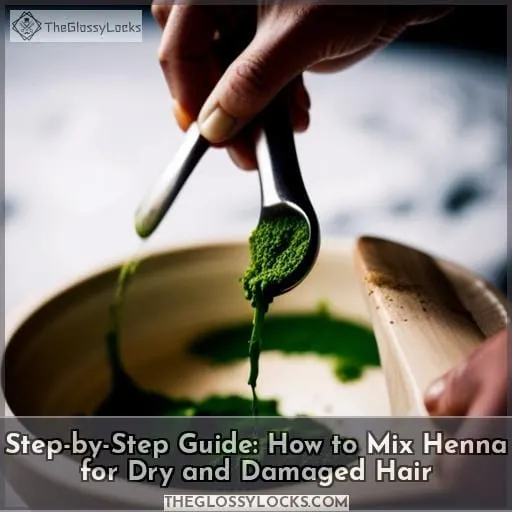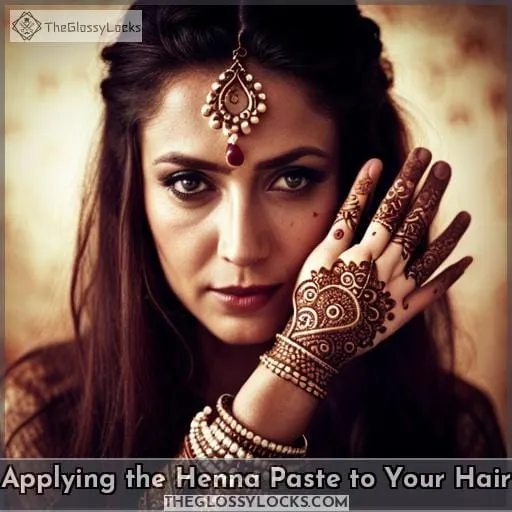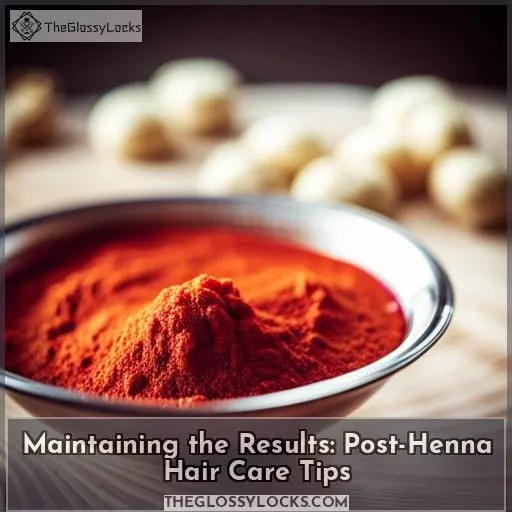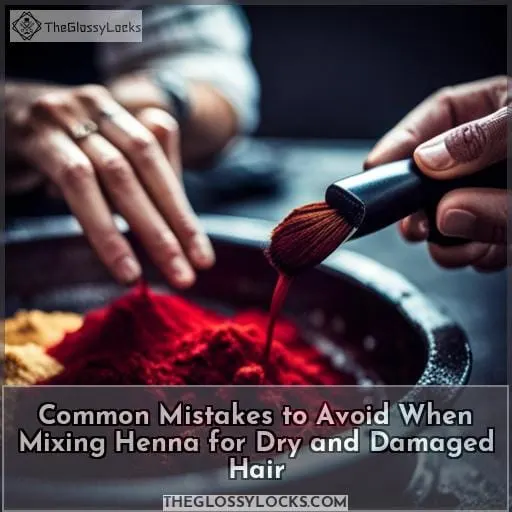This site is supported by our readers. We may earn a commission, at no cost to you, if you purchase through links.

In this article, we’ll cover how to mix henna specifically for reviving dry and damaged hair.
Table Of Contents
- Understanding the Benefits of Henna for Hair
- Assessing Your Hair’s Condition: is It Dry and Damaged?
- The Science Behind Henna: How Does It Work on Hair?
- Step-by-Step Guide: How to Mix Henna for Dry and Damaged Hair
- Applying the Henna Paste to Your Hair
- Allowing the Henna to Set: How Long Should You Wait?
- Rinsing Out the Henna: Tips for Smooth and Healthy Hair
- Maintaining the Results: Post-Henna Hair Care Tips
- Common Mistakes to Avoid When Mixing Henna for Dry and Damaged Hair
- Conclusion
Understanding the Benefits of Henna for Hair
When it comes to reviving dry and damaged hair, henna offers several benefits. First and foremost, henna acts as a natural conditioner for your hair, providing deep hydration and nourishment. Additionally, it strengthens the hair strands from within, making them less prone to breakage.
Lastly, henna helps restore the natural pH balance of both your scalp and hair follicles for optimal health.
Henna as a conditioner
Using henna as a conditioner can offer numerous benefits for your hair. It deep conditions and restores moisture balance, making it great for dry and damaged hair.Henna also strengthens the hair, adds shine, and promotes overall hair health. Incorporating henna into your natural remedies routine is a powerful way to achieve healthier locks.
Henna for hair strength
Henna strengthens your hair, making it healthier and more resilient.It provides numerous benefits for your hair, including:1) Restoring moisture balance to prevent dryness2) Protecting the cuticles of your hair strands3) Promoting scalp health by improving blood circulation
Restoring hair’s pH
To restore your hair’s pH balance, begin by rinsing with a vinegar solution. This helps to rebalance the acidity of your scalp and hair, promoting overall hair health.Maintaining proper pH levels is crucial for moisture restoration and scalp care. Incorporating an apple cider vinegar rinse into your henna routine can contribute to healthier locks.
Assessing Your Hair’s Condition: is It Dry and Damaged?
If your hair feels dry and damaged, you may be wondering if henna can help revive it. Assessing the condition of your hair is an important step in determining whether henna treatment will benefit you. Here are four ways to assess your hair’s condition:1. Check for moisture balance: Dry and damaged hair lacks moisture, so look for signs of brittleness, frizz, and split ends.
2. Evaluate the texture: Damaged hair often feels rough or coarse to the touch due to raised cuticles.3. Consider previous damage: If you have chemically treated or heat-styled your hair in the past, it may require extra care and repairing.
4. Observe any changes in color or shine: Hair that has lost its natural luster may indicate damage that needs attention.By carefully assessing these factors, you can determine if henna application is a suitable solution for repairing damage and restoring health to your locks.
The Science Behind Henna: How Does It Work on Hair?
Henna works on your hair through a complex process that involves its unique chemistry and the interaction with your hair’s structure.
Henna Chemistry: The key component of henna is lawsone, a natural dye molecule found in the leaves of the Lawsonia plant.
Hair Interaction: When applied to your strands, henna penetrates the outer layers of cuticles and temporarily plumps them up.
Color Impact: The resulting color from henna can vary depending on factors like application time, starting shade of hair, and individual differences in absorption.
Moisture Balance: Alongside providing color intensity, hennas also help balance moisture levels in your locks by retaining natural oils while preventing excessive dryness or oiliness.
Step-by-Step Guide: How to Mix Henna for Dry and Damaged Hair
When mixing henna for dry, fragile hair, you’ll want to start by choosing a gentle, body quality henna powder. Then add natural humectants like honey or aloe vera to the mix for an extra moisture boost.
You can also adjust the consistency of the paste by adding more water for easier application and rinsing from delicate strands.
Choosing the Right Henna Powder
Select a 100% natural henna powder free of metallic salts to rejuvenate dry, damaged hair. Quality henna nourishes strands while gently coloring for long-term revitalization.
Henna powder mixed into a paste and applied to hair strands can provide deep hydration and conditioning to dry, damaged hair. The natural pigments in henna also gradually deposit color into hair that can cover grays and enhance shine.
The resulting conditioning and color from henna lasts longer than chemical dyes without damaging already compromised strands. For best results, check for high lawsone content when selecting henna powder, as this is the active ingredient that bonds with keratin in hair to provide color.
Mix henna powder with a mildly acidic liquid like lemon juice, apple cider vinegar, or plain yogurt. The acidity helps release the dye from the henna plant particles. Use enough liquid to form a thick creamy paste similar to yogurt.
Test consistency and adjust liquid as needed. Apply to clean, dry hair and leave the paste on for at least two hours before rinsing thoroughly.
Adding Natural Moisturizing Ingredients
You can add nourishing oils and butters to your henna hair dye mix to help restore moisture and softness to parched, brittle strands.
Olive, coconut, or avocado oil will provide hydration without diluting the henna.
Shea or cocoa butter will also deeply moisturize and condition dry hair.
When mixing henna for damaged hair, these ingredients act as natural conditioners.
Adjusting the Consistency of the Henna Paste
Your henna paste’s consistency is crucial for effectively coating each strand without dripping or getting patchy.
Add olive oil, lemon juice, or plain yogurt in small increments if the mix is too thick.
For a runny mix, incorporate more henna powder gradually until reaching a smooth, yogurt-like consistency that adheres easily to hair without running.
Applying the Henna Paste to Your Hair
After preparing your henna paste and sectioning your hair, you’re ready to apply the mixture.
Focus on thoroughly coating each section while protecting your skin and clothing for a mess-free process.
Carefully distributing the paste ensures maximum coverage and dye uptake.
Protecting Your Skin and Clothing
After preparing your henna mix, it’s important to protect your skin and clothes when applying it to your hair.
Use an old t-shirt and hair dyeing brush to apply the henna. Wear gloves and apply petroleum jelly to skin around hairline and ears to prevent stains.
Keep a towel handy to catch drips and wear a shower cap.
Change into dark or old clothes to prevent stains during the henna processing time.
Sectioning and Applying the Henna Paste
Each section of your hair needs to be thoroughly coated with the henna paste for maximum dye uptake and conditioning.
Carefully divide hair into sections. Wear gloves.
Apply paste generously from roots to ends using a tinting brush, working one section at a time.
Wrap head in a plastic shower cap.
Allow 1-6 hours for lawsone to bind to keratin.
Rinse thoroughly.
Shampoo gently once paste is removed.
Ensuring Even Distribution and Coverage
Even application of the henna compound across your locks ensures complete coverage for optimal conditioning and color results.
Work in sections to thoroughly coat each strand. Use a tinting brush to apply henna at the roots.
Massage the paste into your hair from root to tip.
Monitor development time for each section.
Rinse thoroughly once processing is complete.
This improves application, prevents unevenness, enhances effectiveness, minimizes staining, and maximizes coverage.
Allowing the Henna to Set: How Long Should You Wait?
After applying the henna paste, patience during the waiting period is required for optimal color results. Henna needs time to release the lawsone molecule that binds to and stains the hair.
Here are some tips for this crucial development phase:
- Wait at least 1-2 hours, up to overnight for maximum color.
- Keep scalp wrapped in a shower cap to retain warmth and moisture.
- Periodically massage scalp to encourage henna release.
- Avoid rinsing too soon, which can prevent lawsone from binding.
- Rinse with cool water first to close cuticles, then shampoo to remove residual paste.
Thoroughly rinsing all traces of henna is key for preventing dryness. Take the time during this step to revive moisture balance and reveal lush, healthy locks.
Rinsing Out the Henna: Tips for Smooth and Healthy Hair
Now it’s time to rinse out the henna paste thoroughly. Be sure to use conditioner and finish with a final cool water rinse for smooth hair.
Rinse the henna paste out completely. Use conditioner to help remove any leftover paste.
Finish by rinsing with cool water. This will smooth the hair and close the cuticle for the best outcome.
Removing the Henna Paste Thoroughly
You’ll want to thoroughly rinse your hair after the indicated processing time to remove all traces of henna for optimally smooth and healthy locks. Use conditioner and cool water for final rinses to lift any remaining grittiness from your strands.
This ensures henna residue is cleared away and your hair’s moisture balance is restored.
Proper post-henna care prevents drying and maintains your hair’s integrity.
Conditioning and Final Rinse
You’d want to condition your hair after rinsing out the henna paste in order to close the cuticle for smoother, healthier-looking locks.
Apply a deep conditioner or henna gloss and let it sit for 10-15 minutes. This helps restore moisture and smoothness.
Rinse with cool water to seal the cuticle.
A final apple cider vinegar rinse can also help close cuticles.
Avoid hot water, which can cause cuticles to reopen.
Maintaining the Results: Post-Henna Hair Care Tips
Now that you’ve successfully applied henna and rinsed it out thoroughly, maintaining your results involves some special aftercare.
To keep your hair looking healthy, shiny, and smooth long after your henna treatment, follow these post-application tips.
This continued care will help you get the most out of your new vibrant color and conditioned locks.
Avoiding Harsh Shampoos and Chemical Treatments
Limit harsh shampoos after henna; they strip color over time.
Use hair masks and natural remedies like coconut or avocado oil to deeply condition.
Incorporate heat protection when styling.
Adjust hair care routines to be gentle.
Incorporating Moisturizing and Nourishing Hair Products
Many nourishing hair products can help you maintain the revitalizing effects of henna after your treatment.
Use deep conditioning masks weekly and leave-in conditioners to keep hair moisturized.
Apply oils like argan or coconut to seal in moisture before and after henna.
These pre and post-henna moisturizing techniques will maximize your treatment’s nourishing potential.
Protecting Your Hair From Heat and Environmental Damage
After hennaing your hair, you’ll want to guard against heat and environmental factors that can diminish your vibrant color and glossy locks.
- Use heat protecting sprays or serums before using hot styling tools.
- Limit washing to 2-3 times per week and use cooler water.
- Apply deep conditioning masks weekly.
- Wear protective styles like braids or hats in harsh weather.
Common Mistakes to Avoid When Mixing Henna for Dry and Damaged Hair
When mixing henna for dry and damaged hair, you shouldn’t add unnecessary ingredients like oils or lemon juice, as they can hinder dye uptake or irritate your skin.
Opt for high-quality body art quality henna without metallic salts. Select ingredients like cassia or indigo for gloss and color depth without drying effects.
Use room temperature or lukewarm water, not boiling, to release lawsone. Mix into a smooth, thick paste without lumps.
Apply evenly throughout your hair, ensuring full coverage. Wrap your hair and let sit 1-4 hours based on your hair’s porosity.
Rinse thoroughly with water first before using a gentle shampoo.
Moisturize hair in following washes to avoid dryness.
Avoiding common mistakes ensures you get optimal dye release and hair health benefits from henna.
Conclusion
Revitalize your ragged ropes with the natural restorative, henna.
Mindfully mix this herbal heal-all to hydrate hurting hair.
Henna’s humectant properties help heal harmed heads by balancing pH and fortifying follicles.
So stir up salvation for your split ends and revive your ravaged ringlets with this ancient antioxidant amalgam.
Henna’s the healthy choice for renewing wrecked waves and winning the war against wear.












